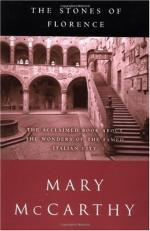|
This section contains 524 words (approx. 2 pages at 400 words per page) |

|
The Stones of Florence Summary & Study Guide Description
The Stones of Florence Summary & Study Guide includes comprehensive information and analysis to help you understand the book. This study guide contains the following sections:
This detailed literature summary also contains Topics for Discussion and a Free Quiz on The Stones of Florence by Mary McCarthy.
The Stones of Florence by Mary McCarthy is a book about ancient Florence and how it thrived from the days of its beginning along the shore of the river Arno. McCarthy's book is the story of the art, architecture and culture of Florence. It is mostly the story of the patronage of the de Medici family and the artists of the area. Most of the great art of the city was done under the patronage of the de Medici family and this is the story Mary McCarthy is telling in this book.
The book opens with a look at modern Florence as it is in 1959, the time the book was written. The city is noisy with the sounds of autos, trucks, motorcycles, scooters, not to mention the bicycles and tourists. Tourists go to Florence because it is the epitome of culture for tourists. It is rich in architecture and art history, its main attractions. At the time it is not well known for its restaurants or its catering to tourists.
The remainder of the book is a look at the past. Whether or not the city was founded by Catiline or not is immaterial. Once the city came into being, it was inhabited by one of the most prosperous people in Europe. The Medicis were world famous bankers and extensive patrons of the arts. Many of the great masterpieces are the result of the de Medici patronage. Many of the great names in art—Giotto, da Vinci, Michelangelo, Donatello and others—were all Florentines and at one time or another worked for the de Medicis on various projects. Florence was not only the center of the Renaissance, it is where the Renaissance began. The arts would not have flouished the way they did if it had not been for the Florentines. Many of the great masterpieces would not have been created.
One characteristic of the Florentines was the desire to be first in many respects. They were the innovators of Italy and the world in not only art, but also in mathematics and science. They developed many of the maps used in navigation as well as much of the equipment. They composed the first opera, organized the first library. They were the first literary critics. They were the first to study the role of power in politics. This desire to be first resulted in their role as innovators, as with Brunelleschi and the dome of the Duomo.
Any disaster that hit the city resulted in the city being rebuilt largely under the sponsorship of the de Medicis. Florence thrived as the art center of the world under the de Medicis. Many of the great masterpieces were commissioned and executed under the de Medici patronage. When the de Medicis were expelled from Florence for the final time, the patronage of the arts basically ended and Florence ceased to be the big center of art that it had been earlier.
After World War II and the end of fascism, free institutions were re-established in Florence and small craftsmen reappeared and Florence is still known for its crafts throughout the world.
Read more from the Study Guide
|
This section contains 524 words (approx. 2 pages at 400 words per page) |

|



